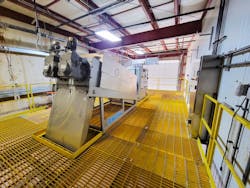The Screw Press for Pressure Sensitive Sludges
Komline-Sanderson
908.234.1000
The screw press has traditionally been identified as a dewatering technology for fibrous sludges. The matting property of fiber allows it to be pressed against a porous screen without extruding through the pores and therefore effectively retained while squeezing out water. When pressure sensitive materials are fed into a screen-type screw press, the pores are eventually blinded and a significant amount of solids are extruded through the screen, making the
process unsustainable.
The KS Multi~Wave Screw Press makes it possible to dewater pressure sensitive sludges, such as waste activated and oily sludges, without the negative effects of blinding and poor capture rates. Instead of a cylindrical screen, alternating fixed and moving rings are stacked to form a cylinder that the screw is then inserted into.
As the screw rotates inside the cylinder, the moving rings rise and fall as they ride on the screw, creating a continuous self-cleaning action. The cylinder is set at an incline to encourage the swift evacuation of liquid and the sludge is progressively stabilized as it moves towards the discharge end of the machine. The combination of these two actions makes it possible to dewater pressure sensitive sludges in a screw press.
K-S recently commissioned a Model MWP-240 Multi~Wave Screw Press at a tofu manufacturing facility in the northeast U.S. to dewater a 50:50 blend of WAS and primary tofu waste, which is a pressure sensitive type of sludge. Feed solids ranged from 3 to 5% TSS. An average throughput rate of 650 dry pounds per hour and cake solids of 25% were realized. Prior to the screw press being installed, the plant hauled out liquid sludge in tanker trucks. Dewatered sludge is now transported in regular dump trucks at a significant cost savings.
